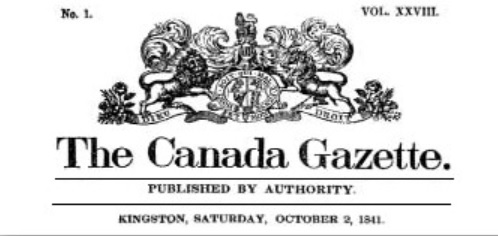The Canada Gazette: official journal of record
 How the Canada Gazette has been informing its readers about important matters that
affect them since 1841 – and has never missed a deadline, through power outages, ice
storms and even major military conflict.
How the Canada Gazette has been informing its readers about important matters that
affect them since 1841 – and has never missed a deadline, through power outages, ice
storms and even major military conflict.
Published since 1841, the Canada Gazette is the government of Canada’s official journal of record. It provides Canadians with access to public notices, official appointments, proposed and enacted regulations, and acts of parliament.
The Canada Gazette consists of three parts that are published separately and contain specific types of notices. Each province and territory of Canada also publishes its own gazette.
Why is the Canada Gazette older than Canada?
Dates matter, especially when examining Canada’s evolution as a country, and the importance of its official journal of record.
On 10 February 1841, the Act of Union took effect, uniting Upper and Lower Canada into the Province of Canada. A few months later, on Saturday 2 October 1841, the Canada Gazette became the official newspaper of the new government, and replaced existing gazettes issued by Upper and Lower Canada.
Then, on 1 July 1867, a proclamation was issued announcing  that the Dominion of Canada was created by dividing the Province of Canada into Ontario
and Quebec, and merging them with the colonies of Nova Scotia and New Brunswick.
that the Dominion of Canada was created by dividing the Province of Canada into Ontario
and Quebec, and merging them with the colonies of Nova Scotia and New Brunswick.
The Canada Gazette, a central, trusted source for disseminating government notices, was created even before the country was founded, and it continues to capture historical moments that shape the nation.
Dark times
The Canada Gazette has also published notices that serve as a reminder of difficult periods in Canada’s past.
Historically, the Canada Gazette was used to release information on quarantines. For example, a proclamation was issued in 1871 concerning a cholera outbreak in Canada.
On 10 September 1939, a proclamation issued by the Governor General and published in the Canada Gazette announced that King George VI had officially declared a state of war with the German Reich.
World War 2 was the deadliest military conflict in our history. Between 2 July 1941 and 30 June 1942, 432 special editions of the Canada Gazette were published.
Cannabis: a first in Canada
The Canada Gazette allows readers to play a part in Canada’s regulatory process by publishing proposed regulations. Interested groups, individuals and all Canadians then have the opportunity to provide their comments on regulations that affect them before they are adopted.
 For example, when Canada became the second country to legalise cannabis, the government
of Canada released notices of intent in the Canada Gazette, proposed and official regulations aimed at achieving a legitimised cannabis industry
that is safe, stable and sustainable. Through these publications, readers could submit
their feedback on cannabis to the government of Canada. Feedback from all parties
was taken into consideration as the regulations were developed and finalised.
For example, when Canada became the second country to legalise cannabis, the government
of Canada released notices of intent in the Canada Gazette, proposed and official regulations aimed at achieving a legitimised cannabis industry
that is safe, stable and sustainable. Through these publications, readers could submit
their feedback on cannabis to the government of Canada. Feedback from all parties
was taken into consideration as the regulations were developed and finalised.
This is one way that the Canada Gazette helps support Canada’s regulatory process by informing its readers about important matters that affect them.
Never late
Dedicated people work at the Canada Gazette to ensure that it is published on time. How dedicated? Well, they have never missed a deadline in the history of its publication.
This is impressive, if you consider that the Canada Gazette has been published during some extraordinary circumstances, such as in times of war, as well as during:
- A major ice storm that crippled Eastern Canada in 1998 and represents one of the largest natural disasters in Canadian history.
- A massive power outage that caused a North American blackout in 2003, affecting 10 million people in the province of Ontario.
Today and in the future
The Canada Gazette is focused on digital transformation to make its publications more accessible to citizens. Designing and delivering digital services that users expect from a modern government will be key to supporting the government of Canada’s digital agenda. Becoming digital will also ensure that the Canada Gazette’s legacy is maintained for many years to come.
The Canada Gazette’s history
Learn more about the history of the Canada Gazette by reading 160 years of the Canada Gazette and In the past fifteen years…a sequel to '160 years of the Canada Gazette'
See also
- London Gazette issue 23254: on 1 July 1867, the Dominion of Canada was created by dividing the Province of Canada into Ontario and Quebec and merging them with the colonies of Nova Scotia and New Brunswick. The proclamation, as well as names of those summoned to the Senate of Canada, was published in The London Gazette on 22 May 1867.
- The New Zealand Gazette
- The Royal Gazette: the official newspaper of the government of Nova Scotia
Images: Canada Gazette masthead; workers in the print shop © Her Majesty the Queen in Right of Canada
